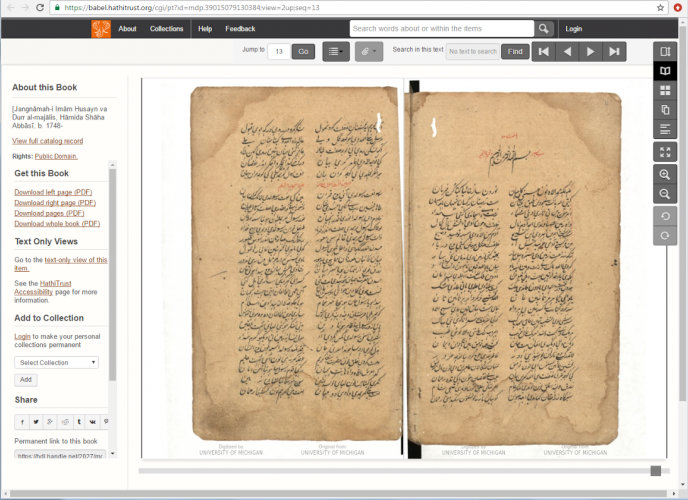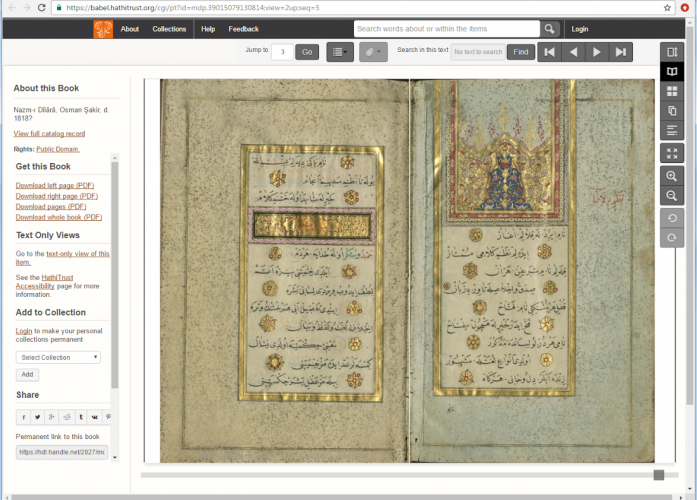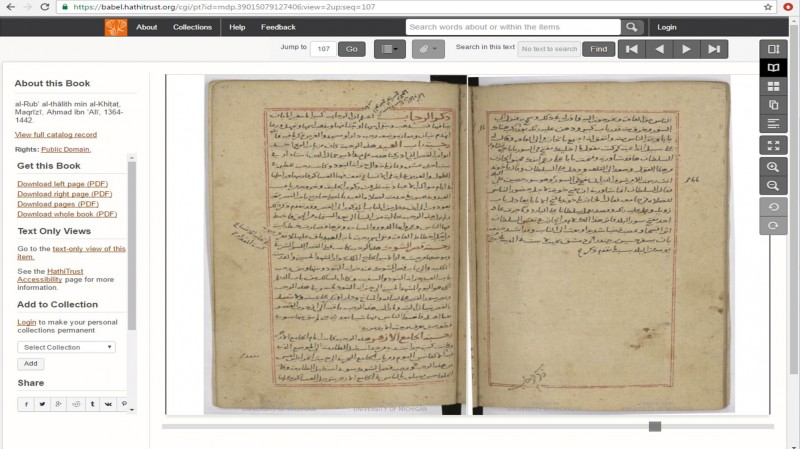An 8-year project to digitize our Islamic Manuscripts Collection is now finished!
The project began in December 2008, when our Library received a CLIR “Cataloging Hidden Collections and Archives” grant [1] to complete the cataloging of our Islamic Manuscripts Collection.
Our cataloging project attempted a novel crowdsourcing approach to compiling the descriptions, and thus provided us with the opportunity to digitize the collection and make it even more accessible to researchers around the world.
Manuscripts were added to the HathiTrust Digital Library as they were digitized and then posted to a project blog site for commentary. As project cataloger, I reveiewed contributions received and incorporated them into the online catalog records.
Thanks to the efforts of this cataloging project (concluded successfully in 2013), the entire collection is now fully cataloged with detailed, searchable descriptions for each manuscript appearing in our online catalog Mirlyn.
In the end, most of the cataloging was left to me and my student assistants, but thanks to the digitized manuscripts, I was able to complete the cataloging far more efficiently than would have been possible otherwise.
And we did receive a few extremely valuable remote contributions!
Isl. Ms. 853 is a splendid example. Four different scholars remotely contributed details to the description of the manuscript’s two main texts, a Panjabi poem on the martyrdom of Imām Ḥusayn and a Persian prose work on ethics. They were able to contribute these details relying on the digitized version of the manuscript in the HathiTrust Digital Library.

View of Isl. Ms. 853 in the HathiTrust Digital Library
Opening of the first text in Isl. Ms. 853, a Panjabi Jangnāmah for Imām Ḥusayn by Hāmida Shāha Abbāsī, copied in 1843 in Aminpur. Image from the Hathi Trust Digital Library.
It was not possible to digitize all the manuscripts in the course of the cataloging project, but since then several more manuscripts have been digitized thanks to the efforts of our staff in the Department of Preservation and Conservation and the Digital Conversion Unit.
Now digitization is complete, and descriptions and full digital surrogates for 1030 manuscripts from the collection appear online!
The digital surrogates are linked from the manuscript descriptions in the online catalogue and it is possible to search for them on terms like shelfmark (e.g. "isl. ms. 529"), title, author, subject, former owner, copyist, and other bibliographical, historical and codicological details.
A list of the digitized manuscripts can also be browsed in the HathiTrust Digital Library.
The high-resolution digital images may be downloaded one by one or collectively in JPG or PDF.
Thanks to our approach to scanning and photography, we have been able to capture even the most radiantly illuminated manuscripts including Isl. Ms. 414.

View of Isl. Ms. 414 in the HathiTrust Digital Library.
View of the close of Isl. Ms. 414, with colophon and seal of the author. Image from the Hathi Trust Digital Library.
We have also been able to image manuscripts in challenging formats such as rolls, including Isl. Ms. 391.
View of Isl. Ms. 391 rolled up.
Image from the HathiTrust Digital Library
View of the opening content of Isl. Ms. 391, a silsilename of the Ottoman sultans through Abdülmecid I (r.1839-1861).
Image from the HathiTrust Digital Library
We are also thrilled that, thanks to our new V-cradle scanner, one of the most significant manuscripts in our collection, Isl. Ms. 605 is now available in its entirety online.
This manuscript comprises the holograph fair copy of the third part of Aḥmad ibn ʻAlī al-Maqrīzī's (d.1442) well-known work on the topography of Cairo and Egyptian history generally, Mawāʻiẓ wa-al-iʻtibār fī dhikr al-khiṭaṭ wa-al-āthār, commonly known as al-Khiṭaṭ. [2] It can now be viewed and downloaded via the HathiTrust Digital Library.

View of Isl. Ms. 605 in the HathiTrust Digital Library
Opening of the section on courtyards (riḥāb) in al-Maqrīzī's Khiṭaṭ as it appears in Isl. Ms. 605, p.103.
Image from the HathiTrust Digital Library.
Beyond the cataloging, the digitized manuscripts have already enabled a host of research endeavors, including a number of fascinating dissertation and book projects.
So many colleagues - in Library Information Technology, the Copyright Office, Preservation and Conservation, Special Collections, and International Studies, as well as HathiTrust - deserve thanks for their work on this project.
Here’s to everyone who contributed, and to the ongoing research made possible by these digitized manuscripts!
[1] This program awarded its final round of grants in December 2014 and has been succeeded by the "Digitizing Hidden Special Collections and Archives" program.
[2] The manuscript was discovered in the course of our cataloging project by then graduate student Noah Gardiner. See Noah Gardiner and Frédéric Bauden, "A Recently Discovered Holograph Fair Copy of al-Maqrīzī's al-Mawāʿiẓ wa-al-iʿtibār fī dhikr al-khiṭaṭ wa-al-āthār (Michigan Islamic MS 605)," Journal of Islamic Manuscripts 2, 2 (2011): 123-131.